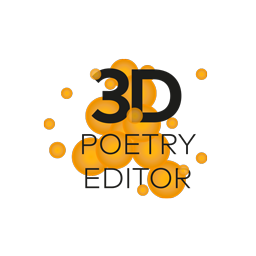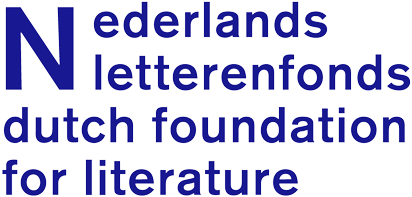About
What is 3D Poetry Editor?
3D Poetry Editor is a text editor for composing poems in three dimensions, using three-dimensional structures, and can also be used to read and distribute three-dimensional poems. 3D Poetry Editor allows writers to compose poems in a virtual three-dimensional space. 3D Poetry Editor adds depth to the two dimensions on which lines of written poetry are usually positioned. Writing in this space and connecting words, lines or complete stanzas creates a three-dimensional structure that enables reading in multiple directions. The reader can navigate the three-dimensional space, read the poem, and explore its spatial construction.
Poetry in Three Dimensions
How does poetry function in three dimensions? What are the formal, structural,
rhetoric, stylistic and poetic possibilities offered by writing in three dimensions?
How does the working process unfold if you can position words in a three-dimensional space,
and see the three-dimensional structure take shape while
writing? What kinds of poems are produced? And how are they different from poems
that are written in two dimensions? Will it result in new ways of thinking about
poetry?
For many poets the page is a 'field of composition', a two dimensional space for
words that can be read in different directions. Especially in the digital realm this led
to experiments with non-linear and multi-dimensional reading that hint at three-dimensionality.
Composing poetry in three dimensions does offer a new dynamic
'text field' in which new, unforeseen meanings can appear. The flexible, changeable
space of words and sentences enables a multi-sequential way of reading, and
emphasises space over time. This changes how readers explore a poem and make
sense of it.
Writing 3D Poetry
In 3D Poetry Editor the writer builds three-dimensional poetic structures by writing and connecting words or lines of poetry - the nodes that create networks or other structures. Three different forces affect the nodes in the virtual space. These forces function as compositional tools, and are somewhat similar to the fundamental forces in our universe. "It was like collaborating with an invisible partner, who was more dancer and weaver than poet, and who would not tell me in advance what he might do next!" Sampurna Chattarji To ensure that the poem does not expand out of control, a gravity centre pulls all the nodes towards the middle of the space. Individual nodes repel each other: they only use their own space and do not overlap with others. When the nodes are connected, they are brought together and pull at each other. These three forces act upon each other, and create a dynamic three-dimensional constellation. They decide how the poem will behave in the three-dimensional space, and determine its organisation. As they do not directly control every detail, poets have to allow for unexpected effects and constructions. They have to find other ways of relating subject matter and form, of creating a poetic effect.
Reading 3D Poetry
The reader of a 3D-poem can navigate the virtual space in a way similar to a 3D computer game, zooming in on details, or zooming out to see the entire structure. The lines and words are suspended in the virtual space; large words are nearby, small ones far away. Some poems look like a mobile, or a three-dimensional representation of molecules, while others resemble a constellation of stars. And sometimes reading a poem is like travelling through space and watching words fly by. Any node can be grabbed, and dragged through the space. Pulling on a piece of the poem reveals how that piece is connected to others, and allows for a positioning of the lines for easier reading. This changes the visual representation of the poem, but not the topology of the network. "Senses are born on the crossings of any lines." Maria Malinovskaya Because the nodes are governed by three forces, which position them in space and in relation to each other, there is in most cases no fixed or preferred reading order. The poem itself is a site for discovery. Reading a 3D-poem also means engaging with a fluid form, or exploring to reveal the underlying structure.
"The beauty of it lies in the fact that it forces you to really think about every line you write. You can't depend on the sequence as it normally is on paper or spoken out loud, so every line has to be attractive, exciting, wrongheaded or whatever enough to keep the reader tempted. Time is of no importance anymore, because there is no beginning or end. The reader determines how he reads the poem and when he or she is done with it." Daniel DeeWhat has been written until now?
Amy Catanzano, Adam Dickinson, Sampurna Chattarji, Maria Malinovskaya, Derek Beaulieu, Morten Søndergaard, Mani Rao, Nils Christian Moe-Repstad, Laura Accerboni, Angela Rawlings, Jan Baeke, Jon Ståle Ritland, Daniel Dee, and Mamta Sagar have used 3D Poetry Editor to create poems. Their poems suggest different formal and compositional possibilities that can be explored in three dimensions. Some meticulously built networks or structures – simple or complex – that corresponded to the subject matter of their poems. For example, in Diamond Jon Stale Ritland mimics the atomic structure of a carbon atom by creating four connections to every node of the poem. Others played with the structural possibilities, allowing the reader reveal the construction through interacting with the poem. The couplets of Amy Catanzano’s Wavicles tie two lines together, foregrounding the dual nature of light and matter as both waves and particles; there is a play of text sizes and overlapping movements, but no linear progression, no beginning or end. Some poets saw working with 3D Poetry Editor as a way to escape the confines of the static page, and embraced the dynamic form and the loosening of authorial control, gaining in the process a fresh perspective on the process of writing. Derek Beaulieu let all the lines from an English translation of Mallarmé’s Un Coup de Dés explode in the virtual space, creating a whirling tension of recombinant text.
The History of 3D Poetry Editor
3D Poetry Editor evolved from BodySearches/PoetryMachine, which combined poems from Jon Ståle Ritland’s BodySearches (2013) with three-dimensional software art by Dutch media artist Michiel Koelink. Successful presentations of BodySearches/PoetryMachine inspired Ritland and Koelink to develop an editor that could write in three dimensions. Prototypes were presented at various festivals, including Poetry International, where poets were invited to compose a new work using the application. Their responses, experiences and critiques were input for subsequent improvements to the application.
"The 3D Poetry Editor opens new possibilities in writing and reading poetry, and also opens new room for what a poem might be. It can make you think differently about poetry, as in my case, by using molecular forms, and writing poems that I otherwise would not have thought of." Jon Ståle RitlandTechnology
3D Poetry Editor is developed by the Dutch media artist Michiel Koelink, the Norwegian poet Jon Ståle Ritland and the Portuguese programmer David Jonas. The application is created with Unity – a program for creating 3D-games. 3D Poetry Editor runs on most current platforms (Windows, Apple, Linux), and can also be embedded in websites. Poems written in 3D Poetry Editor are saved as a .3dpff file. 3D Poetry Editor is open source, and is published under a Creative Commons licence. Authors retain the copyright of the poems they write with 3D Poetry Editor.
3D Poetry Editor is made possible thanks to a grant from the Dutch Foundation for Literature.


